To help raise the global profile of geology, Murray Gray proposes launching an international project on geotourism
In 2014, the Geological Society of London, together with partner organizations, ran a “100 Great Geosites” project in the UK and Ireland (
https://www.geolsoc.org.uk/100geosites). Over 400 sites were nominated and these were supplemented by sites suggested by an expert group. The public were then invited to vote for their favourites. 1,500 votes were received, with the 100 most popular being placed into 10 groups.
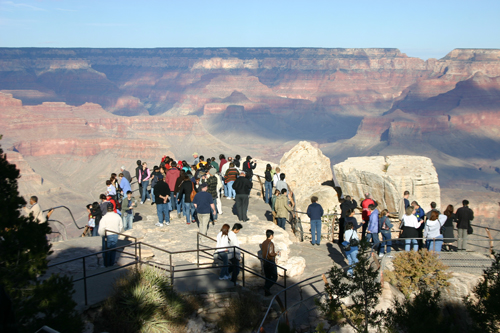 Left, Geotourists admiring the internal geodiversity of the Grand Canyon, USA. Photo: Murray Gray.
Left, Geotourists admiring the internal geodiversity of the Grand Canyon, USA. Photo: Murray Gray.
When published in October 2014, according to Prof. Rob Butler, Chairman of the Geoconservation Committee, there was a “pretty major media storm” amounting to some of the largest ever media interest in a Geological Society topic, with several newspapers publishing the story.
Given the low profile of geology, geoheritage and geoconservation in many countries, perhaps there is a case for repeating the project at a global scale, allowing publicity for the results to be achieved through national and international outlets?
Selection
We would need to determine how many sites to select, whether to order them and what criteria to use in our selection. Certainly, the public must be able to easily and safely visit the chosen locations, so we should select the top geotourism sites. We must also consider visual impact, site quality, educational potential and the availability of sufficient tourist facilities. There should also be a reasonably wide distribution of sites from across the globe, rather than many sites being from a single continent, and the sites should reflect the geodiversity of the planet, rather than many being from only one field of geology.
Provisional list
With these strictures in mind, I have selected a provisional ordered list of 10 sites and welcome comments on these:
1. Iguaçu/Iguazu Falls (Brazil/Argentina) or Victoria Falls (Zimbabwe/Zambia);
2. Grand Canyon National Park (USA);
3. Great Barrier Reef (Australia);
4. South China Karst to Ha Long Bay (China/Vietnam);
5. Yellowstone National Park (USA) or Hawaii Volcanoes National Park (USA);
6. Uluru (Australia);
7. Central Swiss Alps (Switzerland);
8. Cal Orcko Parque Cretácico (Bolivia);
9. The “Golden Circle” Route (Iceland);
10. Cape Town (S. Africa) or Rio de Janeiro (Brazil)
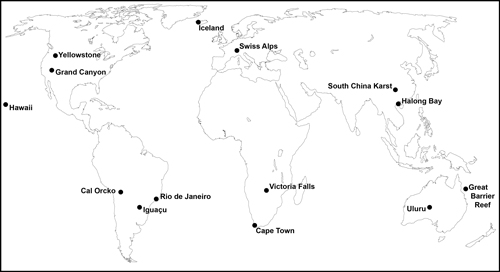 Right, Distribution of the main sites mentioned in the text.
Right, Distribution of the main sites mentioned in the text.
Many of these will be familiar to readers but an explanation of some may be useful.
Iguaçu Falls
The Iguaçu/Iguazu Falls are placed first because they represent the world’s most spectacular and complex waterfall system, with 275 individual falls tumbling over two main horizontal lava flows. The falls are a major tourist attraction, visited from both the Brazilian and Argentinian sides.
Most geosites are static, but here is a highly dynamic one that has good tourist facilities, including trails out over the water, helicopter and boat trips, visitor centres and restaurants. On seeing these falls, US First Lady, Eleanor Roosevelt, is reputed to have exclaimed “Poor Niagara”. So, rather than the Niagara Falls being selected as an alternative waterfall site, the Victoria Falls are chosen instead.
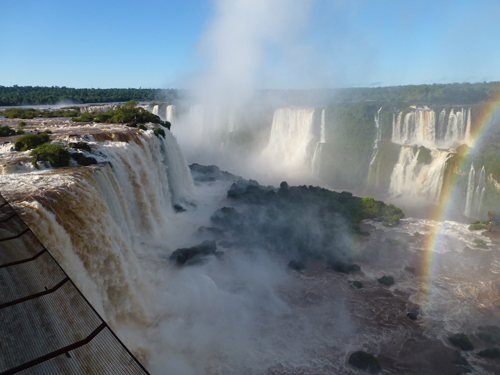 Left, An example of waterfall diversity at Iguaçu/Iguazu Falls, Brazil/Argentina. Photo: Murray Gray.
Left, An example of waterfall diversity at Iguaçu/Iguazu Falls, Brazil/Argentina. Photo: Murray Gray.
Great Barrier Reef
The Great Barrier Reef is perhaps a surprise appearance on this list, since many visitors are more interested in the reef ecology rather than its geology and geomorphology. However, it is believed that the reef started to grow 20,000 years ago, when world sea-level was 120 m lower, during the Last Glacial Maximum. As sea-levels rose, coral growth was able to keep pace and has created the massive structure we see today, composed of nearly 3,000 individual reefs and almost 900 islands stretching over a distance of 2,300 km. Accessibility is good with several resorts on islands on the reef, boat trips (including glass-bottomed boats) and cruises, as well as helicopter flights.
South China Karst
There ought to be a karst site on the list and the one selected is South China Karst to Ha Long Bay, which together form part of a north-south karst transect stretching for a distance of over 1,000 km.
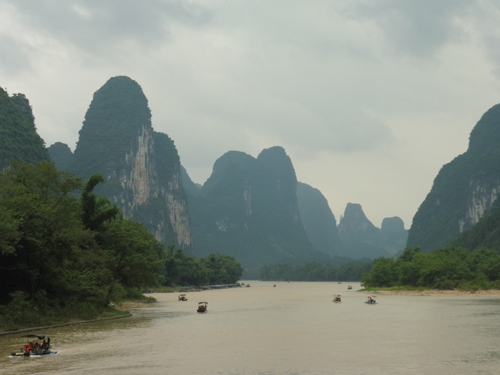 Right, Tourist boats on the River Li within the Guilin section of the South China Karst. Photo: Murray Gray
Right, Tourist boats on the River Li within the Guilin section of the South China Karst. Photo: Murray Gray
This transect contains world-class examples of tower karst and cone karst, as well as giant dolines, river gorges, cave systems and the stone forest of Shilin. Together, they constitute the world’s finest examples of humid tropical and subtropical karst and many parts have been inscribed as World Heritage Sites. Ha Long Bay represents an area of flooded tower karst with over 1,500 islands. The individual parts of the transect are mainly accessible by river boats or tourist ships, and they represent a spectacular diversity of tower karst landscapes and caves.
Cal Orcko
The most impressive in situ dinosaur site in the world must be the dinosaur footprint site at Cal Orcko, near the city of Surce in southern Bolivia. First discovered by quarry workers in 1985, the quarry face now displays over 5,000 footprints in 462 trails from 15 dinosaur species and is the largest dinosaur footprint site in the world.
The site is known as Parque Cretácico and has been on Bolivia’s World Heritage Tentative List since 2003. The footsteps were made in clay on a former shoreline, but they are very fragile and are subject to weathering. There is a museum on the site from which guided tours for visitors are run around lunchtime when the lighting conditions are at their best.
Golden Circle
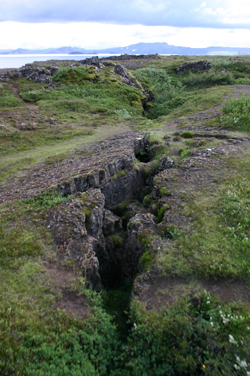
The so-called “Golden Circle” is a mainly geological tourist route in south-west Iceland. It includes the impressive tectonic site of Thingvellir where the North American Plate and European Plate are moving apart at about 3 cm per year, resulting in open fissures, some of which have walking or canoe trails through them. It is therefore a major site for tourists to observe plate tectonics in action. Also on the Golden Circle route is the Strokkur Geyser, the impressive Gullfoss waterfall and the Kerio volcanic crater. In addition, it is possible to visit the local geothermal power plants.
Left, Tension fractures produced by the divergence of the North American and European tectonic plates, Thingvellir, Iceland. Photo: Murray Gray
Cape Town and Rio
I have chosen the last two sites because both reflect the important and close association between human settlements and their physical settings. Cape Town is a city with the spectacular backdrop of the 1,000-m-high Table Mountain, which is accessible by either hiking trails or cable car. The city and coastline of Rio de Janeiro are dominated by several gneissic bornhardts, including the Sugar Loaf and Corcovado mountains, the latter with its huge statue of Christ the Redeemer. The coastal plain is formed of Quaternary sediments and the coastline itself is dominated by the sandy beaches of Copacabana, Ipanema and Leblom.
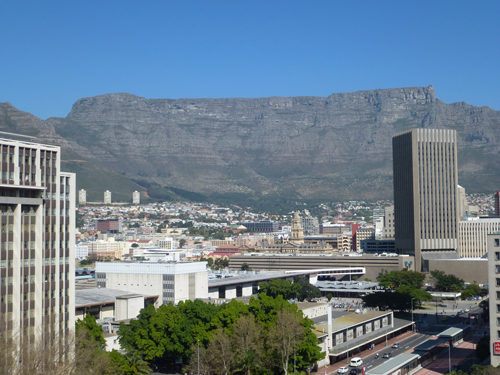 Right, Table Mountain dominating the city of Cape Town, South Africa. Photo: Murray Gray.
Right, Table Mountain dominating the city of Cape Town, South Africa. Photo: Murray Gray.
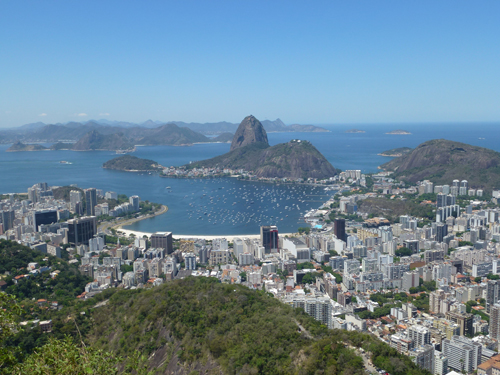
Left, The view of Sugar Loaf Mountain and part of the Harbour from Corcovado, Rio de Janeiro, Brazil. Photo: Murray Gray.
Up for debate
These 10 sites are not intended to be the final, definitive list (and I welcome comments on these suggestions). Rather, they are intended to be the start of a process that may eventually lead to a list of top geotourism sites endorsed by the geological community, which can then be promoted to the public through the media. This endorsement should come through national and international organisations such as the Geological Society of London, as well as the IUGS’s
International Commission on Geoheritage and the IUCN’s
Geoheritage Specialist Group.
Murray Gray (FGS) is Honorary Professor in the School of Geography at Queen Mary University of London; e-mail: [email protected]
FURTHER READING
Gray, M. (2013). Geodiversity: valuing and conserving abiotic nature. 2nd ed. Wiley Blackwell, Chichester. 495pp.
Gray, M. (2020). “Simply the best”: the search for the world’s top geotourism destinations. In Sadry, B.N. (ed) The geo-tourism industry in the 21st century. Apple Academic Press, New Jersey, in press.